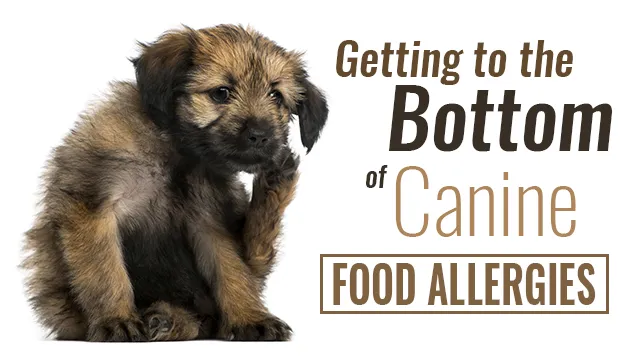Unlike cats, who are strict carnivores, dogs are omnivores. You may have a dog who literally lives up to that name, eating just about anything. Dogs with food allergies may react to any trigger in the diet — and getting to the bottom of it can take some time and effort.
Food allergy symptoms
In humans, reaction to food allergies — such as nuts or shellfish — often results in respiratory distress. This is not the case with canines. Most allergies in dogs manifest themselves as skin issues. These include:
- Constant scratching
- Ear infections
- Hair loss
- “Hot spots”
- Skin lesions
Many of these symptoms also occur in dogs suffering from flea allergy dermatitis. If your dog is on an effective flea-control regimen and experiences any of these skin problems, take him to the vet for diagnosis and treatment.
Common food allergies
Food allergies generally occur because the dog’s body reacts badly to a particular protein, whether that protein derives from meat, grain or vegetable consumption. There are certain proteins more likely to cause an allergic reaction, according to The Merck Veterinary Manual. These include:
- Beef
- Dairy
- Eggs
- Chicken
- Soy
- Wheat
- Corn
Additives found in dog foods can also cause allergies. If you’ve consistently fed your dog a food with just one protein source, such as chicken, narrowing down the allergic component is much easier.
Breed predisposition
While any dog might develop a food allergy, certain breeds are prone to the problem. Purebred or mixed breed, canine food allergy symptoms can appear at any age. Susceptible breeds include the:
- Boxer
- Collie
- Cocker spaniel
- Dachshund
- Dalmatian
- German shepherd
- Labrador retriever
- Lhasa apso
- Miniature schnauzer
- Shar-pei
- Soft-coated wheaten terrier
- Springer spaniel
- Weimaraner
- West Highland white terrier
Dogs with food allergies should not be bred, as the reaction may have a genetic basis.
Food allergy diagnosis
Since environmental and contact allergies also appear as skin problems, your vet may conduct blood and skin testing to make a diagnosis. If these tests are inconclusive, it’s likely a food allergy is the source of your dog’s misery. There’s no truly reliable test to definitively diagnose a food allergy. Instead, it’s a matter of trial and error, beginning with an elimination diet.
Elimination diets
The elimination diet consists of a single protein and single carbohydrate food that your dog has never eaten before. A meat source such as venison, duck, rabbit, fish or even kangaroo is often part of the trial diet, while carbohydrate sources generally consist of sweet or white potato, or oatmeal.
While the dog is on the elimination diet, he can’t eat anything other than that particular food. That means no treats, supplements, table scraps or even flavored toothpastes. If your dog requires medication, ask the vet about a suitable “delivery system” — wrapping pills in cheese or meat is no longer an option.
Your dog stays on the elimination diet for a minimum of three months. If his symptoms disappear, your vet will instruct you to transition your dog back to his original brand or type of food. If the symptoms recur — which may happen within hours or take weeks to appear — it’s probable that the dog is indeed allergic to proteins in the food. Start feeding the dog the elimination diet until he’s again asymptomatic. At that point, your vet will instruct you to start adding individual ingredients that may have triggered the reaction. For example, if you previously fed your dog a food primarily containing beef and wheat, you would add beef to your pet’s diet and wait at least a few weeks to see if symptoms returned. If they do, it’s likely he’s allergic to beef. If symptoms don’t return, your vet will ask you to add wheat and repeat the process. It’s all about pinning down the food allergy trigger. Of course, if you simply want to continue feeding the single protein/carbohydrate elimination diet for the rest of your dog’s life, that’s a viable choice.
If once you don’t succeed …
Unfortunately, if the initial food elimination trial doesn’t work, it’s back to the drawing board. That means going through the whole process again, but this time with a different single or limited protein source. If nothing seems to work, your vet may prescribe a special, hydrolyzed diet. The proteins in this diet are broken down into extremely small particulars, and your dog’s immune system doesn’t recognize them as allergens.
Don’t give up
Dealing with a canine food allergy is frustrating, but don’t give up on your best friend. It’s a long process, but eventually you’ll find a food your dog’s body tolerates.
-Jane Meggit
Jane Meggitt graduated from New York University and worked as a staff writer for a major New Jersey newspaper chain. Her work on pets, equines and health have appeared in dozens of publications, including The Daily Puppy, The Nest Pets, Horse News, Hoof Beats and Horseback magazines.
Sources:
http://www.treehugger.com/pets/your-dog-scratching-because-meat-allergy.html
http://moderndogmagazine.com/articles/food-allergies-101/15131
http://www.peteducation.com/article.cfm?c=2+2082&aid=143
https://www.purinaveterinarydiets.com/pet-food-nutrition/canine/canine-health-conditions/allergies
http://www.merckvetmanual.com/mvm/integumentary_system/food_allergy/overview_of_food_allergy.html
https://vetmed.tamu.edu/news/pet-talk/itchy-dogs-%E2%80%93-is-food-the-problem

